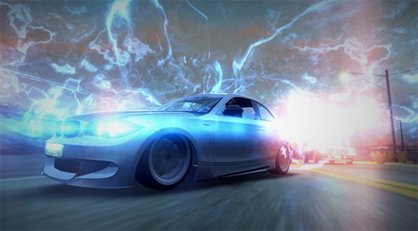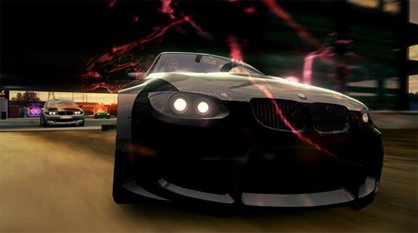Blur
Hands-on with the 'PGR for everyone' combat racer
"Over the past four or five years there's been blockbuster after blockbuster… and none of them are racing games," ponders a thoughtful – and limping thanks to a skiing accident – Bizarre Creations MD Martyn Chudley.
"It feels like there's really been no innovation or push forwards at all in the racing game space - or if there is innovation it's in such a hardcore area," he adds from the corner of the office board room. "What's changed? Rewind 20 years and racing was the genre. You had Super Hang-On, Micro Machines, Outrun… the whole genre feels like it's become niche and specialist."
"… except for Mario Kart," he adds. We can see the PGR hardcore frowning already. "Mario Kart plays on its strengths," he says.
Enter Blur; the result of Bizarre's mission to "bring the fun back" to real racing. It's a faster, less reality-obsessed racer than PGR; 20 licensed cars tear around the track at once, with their headlights painting neon trails through the air and Wipeout-style Power-ups shaking the foundations of the Los Angeles storm drain.
After looking closely at the dwindling interest in 'straight-laced' race sims (GRiD is given as one example of an excellent sim "doing nothing" at market), the PGR house decided to swap the technical side of the genre for just the "excitement and emotion" of getting behind the wheel.
"No one wants to spend years learning how to be Louis Hamilton, you want the final lap where he won the championship. That's what we want to centre on," explains community man Ben Ward.

The Bizarre boys in the board room describe Blur as a game no longer held back by reality. The game's locations, though set in real-world cities, aren't handcuffed to authenticity. One track for example, based on London's Hackney (we're not joking) contains all the instantly recognisable pubs, bridges and estates (one journalist found his girlfriend's flat) but crucially roads have been flipped and roundabouts moved for a more gameplay-friendly course.
Weekly digests, tales from the communities you love, and more
It's a small change on paper but the results are instantly obvious; tearing through Hackney in a Mitsubishi Evo is a swift, 100mph experience compared to the constant 'stop-start' of PGR's authentic tight corners.
PGR fans needn't be too worried either: Vehicle handling still feels very much in Bizarre's traditional arcade territory and carving perfect racing lines, though not as crucial as in PGR, is an effective method of beating the pack.
The 70 licensed cars in the game include Evos, Mustangs, SUVs and Bizarre-made concept cars approved especially for the game by manufacturers – a first, the studio claims.

With the motor count bumped up to 20, Blur is frantic, collision-filled scramble for the finish – and another crucial change is the removal of PGR's trademark roadside barriers; drive off the track and instead of a race-ruining crash you're hampered by the odd collision with a bench or bollard. Bizarre compares this to the "grey areas" in F-Zero, but truth be told it also adds a ton of personality to the courses themselves.
"We could've done Westminster, we could've done Big Ben," explains Chudley, but instead the Blur team decided to go with less obvious choices like Brighton, Hackney as well as Barcelona and San Francisco.
"In PGR we used to hate the gamer," exclaims the boss. "'You've completed this on silver… that's a bit shit isn't it? You should be doing it on gold' We never gave gamers enough reward. Less than 1% of players finished any PGR on platinum. So we thought, why are we focusing on those 1%? Why don't we focus the game on the other 99%?"
And that's where the Mario Kart bit comes in – the power-ups. "The hardcore are going to go 'weapons in a racing game? No'," says designer Gareth Wilson.


